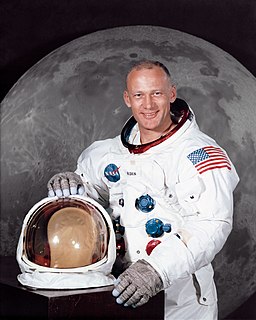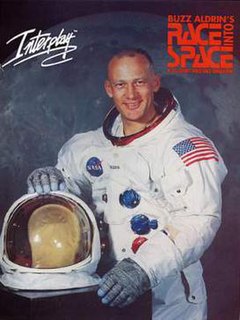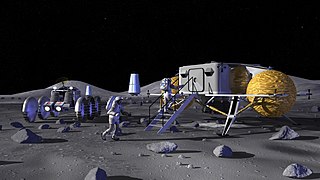Related Research Articles
The Mars Society is a nonprofit organization that advocates for human Mars exploration and colonization, founded by Robert Zubrin in 1998. It is based on Zubrin's Mars Direct plan, which aims to make human mission to Mars as lightweight and feasible as possible. The Mars Society aims to garner support for the Mars program by lobby the United States and other governments.

Buzz Aldrin is an American former astronaut, engineer and fighter pilot. He made three spacewalks as pilot of the 1966 Gemini 12 mission. As the Lunar Module Eagle pilot on the 1969 Apollo 11 mission, he and mission commander Neil Armstrong were the first two people to land on the Moon.

The Planetary Society is an American internationally-active non-governmental nonprofit organization. It is involved in research, public outreach, and political space advocacy for engineering projects related to astronomy, planetary science, and space exploration. It was founded in 1980 by Carl Sagan, Bruce Murray, and Louis Friedman, and has about 60,000 members from more than 100 countries around the world.

The National Space Society (NSS) is an American international nonprofit 501(c)(3) educational and scientific organization specializing in space advocacy. It is a member of the Independent Charities of America and an annual participant in the Combined Federal Campaign. The society's vision is: "People living and working in thriving communities beyond the Earth, and the use of the vast resources of space for the dramatic betterment of humanity."

The planet Mars has been explored remotely by spacecraft. Probes sent from Earth, beginning in the late 20th century, have yielded a large increase in knowledge about the Martian system, focused primarily on understanding its geology and habitability potential. Engineering interplanetary journeys is complicated and the exploration of Mars has experienced a high failure rate, especially the early attempts. Roughly sixty percent of all spacecraft destined for Mars failed before completing their missions and some failed before their observations could begin. Some missions have met with unexpected success, such as the twin Mars Exploration Rovers, Spirit and Opportunity which operated for years beyond their specification.

The Vision for Space Exploration (VSE) was a plan for space exploration announced on January 14, 2004 by President George W. Bush. It was conceived as a response to the Space Shuttle Columbia disaster, the state of human spaceflight at NASA, and as a way to regain public enthusiasm for space exploration.

Colonization or settlement of Mars is the human migration and long-term establishment on Mars. It has received interest from public space agencies and private corporations, and been extensively explored in science fiction writing, film, and art.

Buzz Aldrin's Race Into Space, frequently abbreviated BARIS, is a 1993 space simulation strategy game for MS-DOS. The player takes the role of Administrator of NASA or head of the Soviet space program with the ultimate goal of being the first side to conduct a successful manned Moon landing. It was developed by Strategic Visions and published by Interplay Productions as a computer version of LIFTOFF!, a 1989 board game developed by Fritz Bronner. BARIS was re-released in 1994 on CD-ROM, incorporating the earlier updates to the floppy disk version, a few new updates, improved video of the mission launches, and new multiplayer modes.

Apollo 11 was the first human spaceflight to land on the Moon. The 1969 mission's wide effect on popular culture has resulted in numerous portrayals of Apollo 11 and its crew, Neil Armstrong, Buzz Aldrin, and Michael Collins.

NASA has made many concepts of moonbases for achieving a permanent presence of humans on the Moon. The American government agency requested an increase in the 2020 budget of $1.6 billion, in order to make another crewed mission to the Moon by 2025, followed by a sustained presence on the Moon by 2028.

A moonbase is a facility on the surface of the Moon, enabling human activity on the Moon. As such, it is different from a lunar space station in orbit around the Moon, like the planned Lunar Gateway of the Artemis program. Moonbases can be for unmanned or manned use, in both cases not necessarily including lunar habitation facilities. A base might be a step towards colonization.

The idea of sending humans to Mars has been the subject of aerospace engineering and scientific studies since the late 1940s as part of the broader exploration of Mars. Some have also considered exploring the Martian moons of Phobos and Deimos. Long-term proposals have included sending settlers and terraforming the planet. Proposals for human missions to Mars came from e.g. NASA, Russia, Boeing, and SpaceX. As of 2022, only robotic landers and rovers have been on Mars. The farthest humans have been beyond Earth is the Moon.
Robert Godwin is a British author who has written about rock music and spaceflight. Early in his career he was a rock music impresario who managed a venue in Burlington, Ontario and founded Griffin Music.

The Phobos monolith is a large rock on the surface of Mars's moon Phobos. It is a boulder about 85 m (279 ft) across and 90 m (300 ft) tall. A monolith is a geological feature consisting of a single massive piece of rock. Monoliths also occur naturally on Earth, but it has been suggested that the Phobos monolith may be a piece of impact ejecta. The monolith is a bright object near Stickney crater, described as a "building sized" boulder, which casts a prominent shadow. It was discovered by Efrain Palermo, who did extensive surveys of Martian probe imagery, and later confirmed by Lan Fleming, an imaging sub-contractor at NASA Johnson Space Center.

Mars to Stay missions propose astronauts sent to Mars for the first time should intend to stay. Unused emergency return vehicles would be recycled into settlement construction as soon as the habitability of Mars becomes evident to the initial pioneers. Mars to Stay missions are advocated both to reduce cost and to ensure permanent settlement of Mars. Among many notable Mars to Stay advocates, former Apollo astronaut Buzz Aldrin has been particularly outspoken, suggesting in numerous forums "Forget the Moon, Let’s Head to Mars!" and, in June 2013, Aldrin promoted a crewed mission "to homestead Mars and become a two-planet species". In August 2015, Aldrin, in association with the Florida Institute of Technology, presented a "master plan", for NASA consideration, for astronauts, with a "tour of duty of ten years", to colonize Mars before the year 2040. The Mars Underground, Mars Homestead Project / Mars Foundation, Mars One, and Mars Artists Community advocacy groups and business organizations have also adopted Mars to Stay policy initiatives.

The space policy of the Barack Obama administration was announced by U.S. President Barack Obama on April 15, 2010, at a major space policy speech at Kennedy Space Center. He committed to increasing NASA funding by $6 billion over five years and completing the design of a new heavy-lift launch vehicle by 2015 and to begin construction thereafter. He also predicted a U.S.-crewed orbital Mars mission by the mid-2030s, preceded by the Asteroid Redirect Mission by 2025. In response to concerns over job losses, Obama promised a $40 million effort to help Space Coast workers affected by the cancellation of the Space Shuttle program and Constellation program.

The Planetary Science Decadal Survey is a publication of the United States National Research Council produced for NASA and other United States Government Agencies such as the National Science Foundation. The document identifies key questions facing planetary science and outlines recommendations for space and ground-based exploration ten years into the future. Missions to gather data to answer these big questions are described and prioritized, where appropriate. Similar decadal surveys cover astronomy and astrophysics, earth science, and heliophysics.
SpaceWorks Enterprises, Inc. (SEI) is an aerospace engineering company based in Atlanta, Georgia, United States that specializes in the design, assessment, hardware prototyping and flight demonstration of advanced space concepts for both government and commercial customers.
Mission to Mars is a 2000 science fiction film directed by Brian De Palma.
References
- ↑ Pearlman, Robert (May 8, 2013). "Moonwalker Buzz Aldrin Launches 'Mission to Mars' Book Tour". Yahoo.com . Retrieved May 12, 2013.
- ↑ "Buzz Aldrin's Mission to Mars: A Review". Space Safety Magazine . 2013-05-06. Retrieved 2017-02-03.
- ↑ "Buzz Aldrin's Mission to Mars: A Review". Space Safety Magazine. 2013-05-06. Retrieved 2017-02-03.
- ↑ "Buzz Aldrin's Mission to Mars: A Review". Space Safety Magazine. 2013-05-06. Retrieved 2017-02-03.
- ↑ "Buzz Aldrin's Mission to Mars: A Review". Space Safety Magazine. 2013-05-06. Retrieved 2017-02-03.



